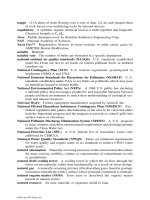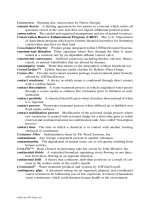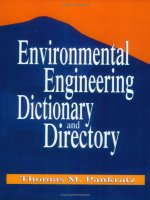Engineering Materials and Processes phần 3 docx
Bạn đang xem bản rút gọn của tài liệu. Xem và tải ngay bản đầy đủ của tài liệu tại đây (308.66 KB, 14 trang )
Diffusion Barriers and Self-encapsulation 19
Figure 3.2. Dealloying kinetics obtained with Ag(26 at.% Ti) alloy films. The residual Ti
concentration is shown as a function of annealing time for three different temperatures. The
annealing took place in a NH
3
ambient and the data was obtained using 2.0 MeV He
+2
RBS
[9].
Resistivity versus annealing time for an Ag(19 at.% Ti) alloy, annealed at three
different temperatures is shown in Figure 3.3. The resistivity drops rapidly within
the first 10 minutes from the high value (~109.0 µΩ-cm) of the as-deposited
sample to ~8 µΩ-cm at 500°C. The initial rapid drop is temperature dependent and
the resistivity change is much slower for longer annealing times. This behavior is
observed for alloy concentrations of 6–26 at.%.
20 Silver Metallization
Figure 3.3. The resistivity as a function of annealing time is shown for an Ag(19 at.% Ti)
alloy, nitrided at different temperatures in NH
3
[9]
3.2.4 Discussion
Nitridation annealing of Ag-Ti alloys above 300°C resulted in Ti segregating at the
surface as well as at the interface. At the surface, Ti reacted with NH
3
and residual
O
2
to form a TiN(O) layer, and at the interface with SiO
2
to form an oxide-silicide
bilayer structure.
The Ti-nitride thickness obtained from nitridation of the Ag(Ti) alloys
increases moderately with temperature in the range 300–600°C, but reaches a finite
thickness (~20 nm) at higher temperatures. The amount of Ti available for reaction
is controlled by the dealloying mechanism, as reflected by the relationship between
the residual Ti concentration and annealing temperature [8].
In the case of Ag-Ti the Ti/SiO
2
reaction occurs at temperatures as low as
350°C. Earlier studies have indicated that significant reaction between pure Ti on
SiO
2
only occurs at temperatures ≥600°C. AES depth profiling analysis has
supported the RBS analysis that nitridation of the Ag-Ti alloys results in the
formation of a Ti-oxide/Ti-silicide structure at the alloy and SiO
2
interface. RBS
analysis indicated no segregation of Ag to the Ti-oxide/Ti-silicide interface for an
Ag(19 at.% Ti) alloy nitrided in NH
3
. Calculations based on the heats of reaction
using the heats of formation of binary alloys, yielded positive values for the change
in enthalpy in all cases. That is, there is no thermodynamic driving force to initiate
the Ag-Ti
5
Si
3
reaction (in contrast to the favorable Cu-Ti
5
Si
3
reaction observed in
Diffusion Barriers and Self-encapsulation 21
Cu(Ti) alloys). This explains the stability of the silver in contact with the
interfacial layers.
Time-dependent dealloying curves for Ag(Ti) alloys are all characterized by an
very rapid initial drop in the Ti concentration within the first 10 minutes followed
by a plateau, which is associated with a small dealloying rate. The residual Ti
showed a strong temperature dependence, namely, at higher temperatures lower Ti
concentrations are obtained. A similar behavior is found in the formation and
kinetics of titanium nitride in Ag/Ti bilayers.
Nitride growth is linear (x ∝ t) in the range 0–15 minutes and parabolic
(x ∝ t
l/2
) for 15–120 minutes. The latter kinetic model implies that a diffusion-
controlled layer is likely to be the rate-limiting process governing the nitridation
reaction. The nitride growth can be limited by diffusion of the reagents (NH
3
or
Ti). For example, Ti diffuses faster through an Ag(100 nm)/Ti(50 nm) bilayer than
Ag(200 nm)/Ti(50 nm).
The alloy results further suggest that the rate-limiting step in the encapsulation
is not the mass transport and reactions within the encapsulating layers. Otherwise,
substantially lower residual Ti concentrations would be obtained in Ag(6 at.% Ti)
compared to Ag(26 at.% Ti) alloy. After being annealed at 500°C for 60 minutes,
these alloys contained residual Ti concentrations of 3.2 and 6.8 at.%, respectively.
More dealloying in Ag(6 at.% Ti) alloy would have resulted if the rate-limiting
step was in the TiN formation. The kinetics are instead likely to be controlled by
the release and transport of the refractory metal in the Ag film.
The factor of 3 increase in grain size, observed after a 500°C anneal is not a
significant enough change to consider Ti mass transport by grain-boundary
diffusion as the limiting process. However, the effect of this increase in grain size
has a significant effect on the grain boundary volume available to accommodate
the Ti atoms upon annealing.
After being annealed above 450°C in NH
3
, the Ag-Ti alloys consist of a TiN(O)
passivation layer, a Ag layer and a Ti-oxide/Ti-silicide bilayer at the alloy/SiO
2
interface. It is assumed that this structure resembles a parallel-resistor
configuration that the conductor (Ag) has the lowest resistance (R
cond
) and it is also
the thickest layer. Therefore, 1/R
cond
» 1/R
passivation
(R
passivation
, resistance of
encapsulation) and 1/R
total
~1/R
cond
or R
total
~R
cond
(after annealing). This assumption
simplified the calculation of the resistivity and resulted in an error of less than 1%.
The resistivity of the nitrided samples is higher than the elemental values. The
lowest resistivities obtained after nitridation for the Ag(Ti) alloy annealed at 500°C
for 30 minutes is 7 µΩ-cm. The higher than elemental resistivity values observed
are believed to be attributed to the following two factors.
Firstly, the presence of residual Ti in the encapsulated Ag films has a great
effect on the resistivity. Time- and temperature-dependent studies of the dealloying
process indicated incomplete dealloying. Even alloys with initial compositions as
low as 4–6 at.% contained up to 1% residual Ti after nitridation at ~600°C.
Lowering the initial Ti concentration would not necessarily lower the resistivity.
Marecal et al. have demonstrated the effect of grain size on the resistivity of Ag
films sputter-deposited on biased glass and silicon substrates [10]. A grain size
change from 28 to 38 nm resulted in a resistivity change from 3.7 to 2.2 µΩ-cm for
22 Silver Metallization
Ag on glass and from 3.5 to 1.6 µΩ-cm for Ag/Si. It has also been shown that the
resistivity of a TiO
2
-passivated Ag layer decreased with annealing temperature due
to increased grain size, from 50 nm for as-deposited sample to 300 nm after
annealing at 600°C [11]. It is believed that annealing of the Cu(Ti) and Ag(Ti)
alloys in NH
3
initiated microstructural changes and other competing reactions
within the first 10 minutes, inhibiting the dealloying.
A second factor that may influence the resistivity is the formation of
intermetallics as a result of the reaction between the Cu (or Ag) and Ti. However,
glancing-angle X-ray diffraction analysis of the Ag-Ti and Cu-Ti alloys, could not
verify intermetallic formation in either system. It has been shown that nitridation of
Cu(Ti) alloys results in segregation of Cu to the Ti-oxide/Ti-silicide interface.
Therefore, the effective thickness of the Cu layer is reduced and this also led to an
increase in resistance of the encapsulated Cu films. Comparison of RBS data of the
Ag and Cu systems indicated no such segregation of Ag to the Ti-oxide/Ti-silicide
interface.
3.2.5 Conclusions
Nitridation of Ag-Ti alloys on SiO
2
, in NH
3
, resulted in a multilayer structure
consisting of a TiN(O) surface layer, a dealloyed Ag layer, and an interfacial Ti
oxide-silicide bilayer. The evolution of the final structure is therefore governed by
a competition between the free surface nitridation/oxidation and the interfacial
reaction. The dealloying behavior was characterized by a rapid decrease in residual
Ti concentration within the first 10 minutes, followed by a much slower diffusion
rate. The residual Ti showed a strong temperature dependence; at higher
temperatures lower Ti concentrations are obtained. It is evident that the rate-
limiting step in the encapsulation is not the mass transport and reactions within the
encapsulating layers.
Resistivities >2 µΩ-cm have been obtained from the encapsulated Ag films.
The main cause of the higher than elemental resistivities is due to the incomplete
dealloying that occurs during the nitridation. The relationship between the residual
Ti concentration and resistivity indicated that the former is controlled by the
dealloying mechanism.
3.3 Corrosion of Encapsulated Silver Films Exposed
to a Hydrogen-sulfide Ambient
3.3.1 Introduction
Silver, unlike a metal such as aluminum, lacks the property of self-passivation and
this deficiency makes it susceptible to oxidation and corrosion during processing
[12]. Dry silver does not form a significant surface oxide under atmospheric
conditions. Czandema showed that at most one monolayer of oxygen atoms adhere
to the silver surface [13].
Diffusion Barriers and Self-encapsulation 23
However, when exposed to an atmospheric environment containing reduced
sulfur gases and either particulate or gaseous chlorine, silver forms corrosion films
consisting largely of Ag
2
S, with some AgCl in high chloride environments. Alloys
of silver behave as does the metal itself unless the alloying element is more
reactive than silver. For example, in the case of “sterling silver” (90% Ag±10%
Cu), the principle corrosion product in a reduced sulfur atmosphere is Cu
2
S,
reflecting the fact that the sulfidation rate of copper is an order of magnitude or
much larger than that of silver [14]. Self-diffusion of unprotected silver surfaces
induces agglomeration of the Ag when annealed at temperatures as low as 200°C
in air. The significant self-diffusion of Ag films during annealing in air is caused
by the absorption of Cl from the air and not by the involvement of oxygen from the
ambient.
Design of back-end-of-line (BEOL) metallization structures for ultra large scale
integrated (ULSI) circuit technology will require careful consideration of the
following electrical and mechanical reliability concerns of the materials used: (1)
resistivity below 3 µΩ-cm, (2) minimal electromigration, (3) metal line adhesion to
dielectrics [15], (4) diffusion barriers to prevent interdiffusion between different
metal levels [15], (5) minimize corrosion during processing and, (6) prevention of
agglomeration upon heating. All these properties except for the low resistivity are
expected to be improved from “encapsulation” of the metal line structures. This
can be accomplished by element additions using Al, Mg, Ti, or Cr to form
interfacial and surface reactions.
These reactions form layers that may provide adhesion, diffusion barriers,
corrosion protection and structural reinforcement, which aid the resistance to
electromigration and agglomeration. Ag films have been successfully passivated by
annealing Ag/Ti bilayers in an oxidizing ambient. The Ti segregates to the free
surface to form a TiO
2
film, which prevented agglomeration of Ag during
subsequent annealing in air.
3.3.2 Experimental Details
Silver-titanium alloy films of approximately 200 nm thick were co-deposited by
electron-beam evaporation with base pressure of ~4×10
–8
Torr onto thermally
oxidized Si(100) substrates with a SiO
2
thickness of ~200 nm. The pressure rose to
~1×10
–7
Torr during deposition.
The initial alloy concentration was 19 at.% Ti. Deposited film composition and
thickness were measured with Rutherford backscattering spectrometry (RBS).
Anneals were performed in a Lindberg single-zone quartz-tube furnace in a
flowing electronic grade (99.99%, with H
2
O<33 and O
2
+Ar <10 molar ppm)
ammonia (NH
3
) ambient. After loading the samples in the furnace, the tube was
sequentially pumped and purged (with ammonia) a minimum of three times. The
NH
3
flow rate was ~2 l/min, and the anneal temperatures ranged from 300±700°C
for 30 minutes. The annealed samples were allowed to cool in the flowing NH
3
before removal from the furnace.
The free surface reaction of Ti with the NH
3
ambient, as well as the Ti-SiO
2
interfacial reactions was analyzed by RBS. RBS analysis was performed using
24 Silver Metallization
a 1.7 MV Tandem accelerator with a 2.0–2.3 MeV He
+2
beam at 7° tilt and total
accumulated charge of 20 µC.
To evaluate the effectiveness of the TiN encapsulation as passivation layers
against corrosion of Ag, the nitrided structures were annealed in a static hydrogen
sulfide (H
2
S) ambient. Quartz test tubes were cleaned with an aqua regia (three
parts concentrated HCl:one part concentrated HNO
3
) acid solution, rinsed with de-
ionized water and dried in an oven at 100°C. After the nitrided samples were
placed in the test tubes, they were evacuated to ~5×10
–5
Torr, and then backfilled
with H
2
S to a sub-atmospheric pressure of ~356 Torr. Anneals were performed
with a wire furnace at temperatures ranging from 100–500°C for 30 minutes. The
furnace was placed around each test tube with sample while connected to the gas
handling manifold.
During anneals, the H
2
S pressure remained essentially constant. For
comparison purposes, as-deposited Ag(19 at.% Ti) alloys and elemental Ag on
SiO
2
were also annealed under the same conditions. A Leica 440 scanning electron
microscope (SEM) operated at voltages between 15 and 25 kV and in secondary
mode was used to evaluate the morphology of the corroded surfaces.
3.3.3 Results
Figure 3.4 compares the RBS spectrum of the as-deposited Ag(19 at.% Ti) alloy
with that nitrided at 600°C for 30 minutes in an NH
3
ambient. After a 600°C
anneal, the presence of a Ti-surface peak and a distinct interfacial Ti peak indicate
that Ti segregated to the free surface and also reacted with the SiO
2
substrate. The
Ti segregating to the free surface reacted with the NH
3
ambient to form a Ti-nitride
layer, labeled as “TiN(O)” in the schematic accompanying the spectrum. At the
alloy/SiO
2
interface, the Ti dissociates the SiO
2
and subsequently reacts with the
freed Si and O to form an interfacial Ti-oxide/Ti-silicide bilayer structure.
These layers are labeled as “TiO” and “Ti
5
Si
3
”, respectively. Computer RUMP
simulation of the spectrum corresponding to the 600°C anneal, suggests that the
dealloyed Ag layer contains a residual Ti concentration of ~0.9 at.%. The TiN
thickness is ~20 nm.
Diffusion Barriers and Self-encapsulation 25
Figure 3.4. RBS spectra showing only the depth distributions of Ag and Ti of a 210-nm
thick Ag(19 at.% Ti) alloy, before and after annealing at 600°C for 30 minutes in NH
3
.
A 2.0 MeV He
+2
beam energy was used [12].
Figure 3.5a shows the RBS spectra of a 170 nm thick Ag film on SiO
2
before
and after annealing in a H
2
S ambient. Annealing the Ag/SiO
2
structure at 100°C for
30 minutes results in sulfidation of the Ag film, as can be seen by the presence of a
small S peak near channel 240. The sulfur peak has been blown up 20 times to
make it more visible. Silver reacts with the H
2
S ambient to form a silver-sulfide
layer of ~11 nm. The slope on the left of the Ag signal is indicative of some
surface roughness induced by the corrosion. The presence of the small sulfur peak
(blown up 20 times) on the RBS spectrum of the as-deposited Ag(19 at.% Ti) alloy
after annealing in H
2
S at 100°C for 30 minutes indicates that corrosion of the alloy
has occurred (Figure 3.5b). The silver sulfide layer is also 11 nm thick. The RBS
data suggest that only corrosion of the silver occurs, since the spectrum shows
depletion of Ag in the surface region, and a slight decrease in the layer thickness.
The Ti peak does not show any changes.
200 300
Channel
0
20
Yield
1.2 1.7
Energy
AS DEP
600
o
C
x4
SiO
2
SiO
2
Ag
19%Ti
Ag
TiO/Ti
5
Si
3
TiN(O)
NH
3
Ag
Interfacial Ti
Surface Ti
26 Silver Metallization
Figure 3.5. RBS spectra of a (a) 170-nm thick sputter-deposited Ag film on SiO
2
and (b)
Ag(19 at.% Ti) alloy film, before and after annealing at 100°C for 30 minutes in H
2
S.
A 2.3 MeV He
+2
beam energy was used [12].
200 400
Channel
0
80
Yield
1.2 2.2
Energy
AS DEP
100
o
C, H
2
S, 30min
S(x20)
Ag
Ti
SiO
2
Ag(Ti)
(b)
200 400
Channel
0
80
Yield
1.2 2.2
Energy
AS DEP
100
o
C, H
2
S, 30min
S(x20)
Ag
(a)
SiO
2
Ag
Diffusion Barriers and Self-encapsulation 27
However, RBS analysis suggest that annealing a TiN(O) encapsulated Ag fillm
in H
2
S at various temperatures for 30 minutes indicates that no corrosion occurs up
to 300°C (Figure 3.6). The sample surfaces retained their smoothness, and golden
color, and no difference between the sample at 300°C (in H
2
S) and the nitrided (no
sulfur anneal) one could be detected. After a 400°C anneal, the RBS spectrum
displays the following features: (1) a reduction in the height and thickness of the
Ag signal, (2) a weak S peak near channel 240, (3) shift of the interfacial Ti signal
to higher energies, and (4) a broad tail. The first three features point to the
formation of a silver-sulfide compound as a result of Ag migration through the Ti-
nitride to react with the H
2
S at the free surface. However, the broad tail on the
spectrum indicates the presence of a discontinuous Ag surface layer.
Annealing the nitrided sample at 500°C for 30 minutes in H
2
S results in an
almost complete diffusion of Ag to the surface. The two Ti signals (interfacial Ti
and surface Ti) merge as a result of this outdiffusion. A much larger S peak is also
present.
Figure 3.6. Ag(19 at.% Ti) alloy was nitrided at 600°C for 30 minutes in NH
3
. The RBS
spectra show depth distributions of the nitrided alloy, after annealing at 300, 400 and 500°C
for 30 minutes in H
2
S [12].
The RBS analysis was supplemented by scanning electron microscopy (SEM).
SEM analysis of the 500°C annealed sample shows the presence of a discontinuous
layer of faceted crystallites. The sample annealed at 500°C has a much higher
density of crystallites than 300°C, and some crystals coalesced to form clusters.
At temperatures ≥300°C the majority of the crystallites display a rhombic shape,
although a few cubic crystals are also visible.
28 Silver Metallization
3.3.4 Discussion
Nitridation anneals of Ag(19 at.% Ti) alloy at 600°C resulted in Ti segregating at
the surface as well as at the interface. The dealloying process appears to take place
by Ti out-diffusion presumably grain-boundary diffusion in Ag with a diffusion
coefficient, which is estimated to be larger than 10
–12
cm
2
/s. At the surface, Ti
reacted with NH
3
and residual O
2
to form a TiN(O) layer of about 20 nm thick; and
at the interface, Ti reacted with SiO
2
to form an oxide-silicide bilayer structure.
The large negative heat of formation of TiO
2
(222–365 kJ/mol) compared to that of
TiN (169 kJ/mol) is compensated by the high partial pressure of NH
3
relative to
that of O
2
, leading to nitride rather than oxide formation. The smaller thermal
decomposition energy of NH
3
(432 kJ/mol) compared to N
2
(942 kJ/mol), makes it
possible to form Ti-nitride at relatively lower temperatures. It has been observed
that at a given temperature (>300°C) similar amounts of Ti diffuse to both the
surface and interface, which implies that the two reactions are in competition for
the finite amount of Ti atoms available. The amount of Ti available for reaction is
controlled by the dealloying mechanism.
Earlier studies also suggest that the reaction between Ti and SiO
2
already
occurs at temperatures as low as 350°C. The interfacial reaction starts with the
dissociation of SiO
2
, the released oxygen and silicon react with Ti to form the
interfacial layers. The layers were identified as TiO and Ti
3
Si
5
[15].
Silver-sulfide films have been recognized as the major corrosion products on
silver and silver-alloys. Both atmospheric corrosion and laboratory experiments
involving mixed corrosive gases reveal that acanthite (Ag
2
S) is a dominant phase.
Hydrogen sulfide (H
2
S) was identified as one of the primary atmospheric
constituents responsible for the degradation of silver, therefore, it “accelerates” the
corrosion of the Ag(Ti) alloys. Alloys of silver produce corrosion products that
reflect the most reactive of the alloyed metals. For the Ag(Ti) alloys, it seems that
Ag is the reactive component, when annealed in H
2
S ambients. SEM studies
showed that the majority of crystallites after corrosion display a rhombic shape,
although a few cubic crystals are also present. These observations suggest that the
corrosion product is Ag
2
S, since acanthite is rhombic and argentite is cubic. This is
in agreement with quantitative energy dispersive spectroscopy (EDS) analysis in
which a Ag/S ratio of, 2.15 was found. It has been shown that Ti is resistant to H
2
S
corrosion [16]. Therefore, it is believed that Ag
2
S (acanthite) is the major corrosion
product formed during the sulfidation of the Ag(Ti) alloys. However, the role (if
any) of Ti during the corrosion process is not clear. The results indicate that as-
deposited elemental Ag and Ag(Ti) alloys, both corroded after being annealed at
100°C for 30 minutes in H
2
S.
The evolution of the corrosion of encapsulated Ag films is depicted
schematically in Figure 3.7. After a 400°C anneal, Ag diffuses through the Ti-
nitride layer to form Ag
2
S crystallites, on the surface. The well-defined sulfur peak
on the spectrum of the sample annealed at 500°C, suggest that the crystallites are
Ag covered with a 133 nm thick layer of Ag
2
S. If the crystallites consisted only of
Ag
2
S non-uniformly distributed over the surface, then the sulfur peak would have
been smeared out. At 500°C, nearly all the Ag had migrated to the surface to react
with H
2
S. It seems that the Ti-nitride barrier fails by allowing diffusion of Ag
Diffusion Barriers and Self-encapsulation 29
through it, without itself being dissolved. It is believed that the diffusion occurs
along grain boundaries and possibly microvoids, pinholes, cracks and weak spots
in the barrier layer. The fact that the TiN passivation layer essentially remains
intact upon failure is also an indication that neither Ti (nor N) reacts with Ag or the
H
2
S ambient at this temperature. Therefore, the migration of Ag to the surface is
driven by the thermodynamically favorable reaction between Ag and H
2
S.
Figure 3.7. Schematic showing the nitridation and evolution of the corrosion process of a
Ag(19 at.% Ti) alloy. At 600°C, in NH
3
, the Ti forms TiN at surface and interfacial
TiO/Ti
5
Si
3
bilayer structure to encapsulate the Ag. At 400°C, in H
2
S, some Ag diffuses
through TiN to form faceted crystallites; at 500°C most of the Ag has moved to the surface
to react with the H
2
S ambient [12].
3.3.5 Conclusions
Nitridation of Ag-Ti alloys/bilayers on SiO
2
, in NH
3
, resulted in a multilayer
structure consisting of: a TiN(O) surface layer, a dealloyed Ag layer, and an
interfacial Ti oxide-silicide bilayer. Ti-nitride layers of thicknesses of ~20 nm are
formed at 600°C [12]. Corrosion of TiN-encapsulated silver thin films in the
presence of a severe hydrogen-sulfide ambient produces a non-uniform surface
layer of rhombic and cubic Ag
2
S crystallites.
Evaluation of the Ti-nitride encapsulation as protection for Ag against
corrosion in H
2
S, showed stability up to 300°C. The unprotected Ag(Ti) alloys and
pure Ag on SiO
2
corroded at 100°C, when annealed under the same conditions.
Numerous studies have shown that tarnishing of Ag occurs at room temperature
and with diluted H
2
S concentration levels of <300 ppb. Therefore, the Ti-nitride
will be an excellent passivation for silver under atmospheric conditions with
degradation occurring only above 300°C [12].
30 Silver Metallization
3.4 Tantalum-Nitride Films as Diffusion Barriers
3.4.1 Introduction
The properties of TaN films are extremely sensitive to film microstructure and
morphology. The chemical composition, microstructure, and properties of TaN
films depend strongly on the deposition parameters, pre-treatment, substrate type,
and film thickness. Diffusion barriers are used to prevent degradation of devices as
a result of poor adhesion and interdiffusion. The objective of research efforts to
date was to find an intermediate layer between the interconnect Ag metal and the
underlying dielectric that will act as both an adhesion promoter and an effective
diffusion barrier between interconnect metal and adjacent materials.
3.4.2 Experimental Details
Tantalum nitride films with nominal thicknesses of about 100 nm were deposited
onto Si (100) substrates by DC magnetron reactive sputtering using various N
2
/Ar
gas flow ratios (15–40% N
2
). A power of 3 kW and a pressure of 8 mTorr were
used. The total flow rate was 100 sccm.
Single-crystal silicon substrates were used, without any specific pre-deposition
clean to remove native oxide. The Ta sputter target was bigger (~ 300–325 mm)
than the substrate wafer (~200 mm) in order to enhance uniformity of the deposited
film. The target-to-substrate separation distance was ~10 cm. During deposition,
the substrate was electrically floating and was held stationary at a temperature of
250–260°C. Rutherford backscattering spectrometry (RBS) using energies of 2–4.3
MeV and total accumulated charge of 10–20 μC were used to analyze the nitrogen
content, oxygen content and composition of the TaN films. The 3.0 MeV and 3.7
MeV beam energies correspond to oxygen (O) and nitrogen (N) resonances,
respectively, and were used to detect O and N. The 3.0 MeV analyses were carried
out at a tilt angle of 65° to increase the relative depth. The RUMP computer
simulation program was used to analyze the RBS spectra. The phases of the as-
deposited TaN films were investigated by glancing angle as well as theta-2 theta
X-ray diffraction analysis (XRD) using a Philips X’pert MPD diffractometer with a
Cu K
α
radiation source. A working voltage of 45 kV was employed and filament
current was 40 mA. Joint Committee for Powder Diffraction Standard (JCPDS)
cards was used for phase identification [17]. To investigate the properties of TaN
film as a diffusion barrier for Ag metallization, a 100 nm–thick Ag layer was
electron-beam deposited on top of the barrier. The samples were annealed at
temperatures ranging from 450°C to 700°C for 30 minutes in a vacuum furnace.
The annealing chamber was pumped down to about 1x10
–10
Torr. During
annealing the vacuum in the furnace was about 1 x10
–8
Torr. Sheet resistances of
the TaN/Si and Ag/TaN/Si structures were measured, both before and after
annealing, using four-point-probe analysis. The resistivity of the TaN/Si samples
was calculated from the sheet resistance obtained from the four-point-probe
measurements and the film thickness measured by a Tencor α-step profilometer.
Diffusion Barriers and Self-encapsulation 31
XRD and RBS analysis using the same parameters and conditions as for the
TaN/Si were also carried out on the Ag/TaN/Si structures before and after the
vacuum anneals.
3.4.3 Results
Figure 3.8 shows the 3.0 MeV RBS spectra of the TaN films, prepared using
different nitrogen flow ratios, on Si. When the nitrogen flow ratio increases to
30% and higher, the thickness of the film decreases. The decrease in thickness
with increasing N
2
partial flow rate is attributed to a decrease in sputtering yield
originating from nitridation of the metal target and/or low ionization efficiency of
the nitrogen gas atoms. The height of the Ta signal decreases with increasing
nitrogen partial flow. This lower Ta yield in the film is due to incorporation of the
lighter element (nitrogen) into the film. At the energy of 3.0 MeV that corresponds
to O resonance no oxygen could be detected in the films within the detection limits
of RBS. To show the presence of nitrogen in the surface layer and to determine the
amount of nitrogen, RBS data were collected at 3.7 MeV (the resonance energy of
N) with a 7°tilt. At the energy of 3.0 MeV, no O and N could be detected.
Figure 3.8. 3.0 MeV RBS spectra from TaN films sputter-deposited on Si, using different
N
2
/Ar flow ratios [5]
32 Silver Metallization
Figure 3.9 shows 3.7 MeV RBS spectra obtained from the tantalum nitride
films prepared using different N
2
flow ratios. At this energy, which corresponds to
N-resonance, large N peaks are visible. This data was used to quantify the nitrogen
content and hence the composition of the samples. The results of these
quantifications are given in Table 3.1.
Table 3.1. Compositions of the TaN films, based on RUMP simulation [5]
Nitrogen flow ratio (%)
Tantalum nitride composition
15 Ta
0.78
N
0.22
20 Ta
0.64
N
0.36
25 Ta
0.55
N
0.45
30 Ta
0.51
N
0.49
40 Ta
0.45
N
0.55
Figure 3.9. 3.7 MeV RBS spectra from TaN films sputter-deposited on Si using different
N
2
/Ar flow ratios. N-resonance peaks are clearly visible at this energy [5].









